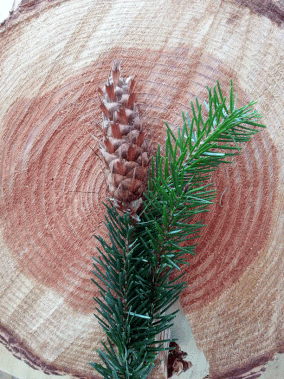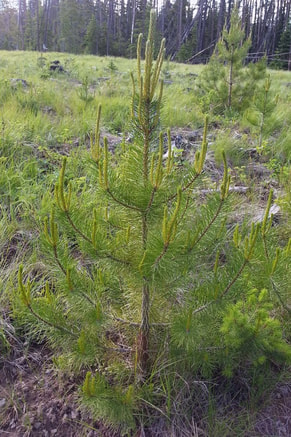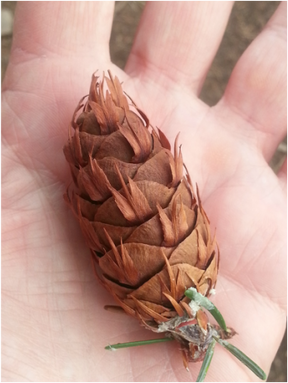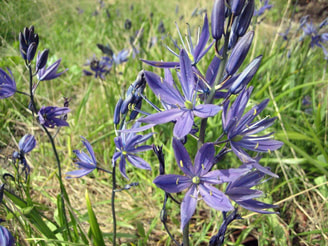Forest and Conservation Science Under Climate Change
Can we maintain wood quality under genetic selection for growth?
|
In addition to taking proactive measures, one strategy to help adapt forests to climate change involves planning for shorter rotations. This ensures the most suitable seed is being used for reforestation by enabling faster response to changing climate conditions. This also involves breeding trees to yield seedlings that grow faster for shorter time-frames. We must also ensure, however, that tree improvement efforts and increased reliance on juvenile wood do not compromise wood density – important for timber quality for construction and carbon sequestration potential.
Choosing the right species and seed source for planting is one of the most important decisions that a forester can make. This project aims to ensure that the most suitable seed is deployed on the landscape for Douglas-fir (Pseudotsuga menziesii) - an important and valuable tree species. The goal is to find the best seed sources and planting strategy by analyzing a suite of growth and wood quality traits in a realized gain trial that tests different levels of genetic selection under varying planting densities. |
What do tree population adaptation to extremes mean for reforestation under climate change?
|
My doctoral work focused on lodgepole pine (Pinus contorta), which is one of the most widespread tree species in western North America. This species shows high ecological amplitude, covering over 4000 km in diverse climates. The more predominant interior variety is particularly important to British Columbia (BC) as a timber species. In recent years, however, major disturbances to lodgepole pine forests have included an unprecedented mountain pine beetle epidemic and large-scale forest fires. Warming climates are also expected to reduce forest growth and survival.
However, lodgepole pine remains an ecologically suitable tree species for reforesting in these areas with some reconsideration of seed zones. There now exists an unparalleled opportunity to re-plant with the most suitable seed sources for a warming climate. Studying how tree populations are adapted to climate and climatic extremes can help us better predict how forests will be respond in the future as well as inform reforestation policy. Therefore, two of the province’s largest forestry problems may help solve one of the next most pressing challenges: mal-adaptation due to climate change. Click here to download a copy of my PhD Thesis (2017): Tree population responses to extreme climate events to guide reforestation under climate change |
Acknowledgements: I am grateful to the B.C. Ministry of Forests, Lands, Natural Resource Operations and Rural Development (FLNRORD) for setting up and maintaining valuable provenance trials, and for granting permission to sample in the Illingworth lodgepole pine provenance trial. Site information and advice was kindly provided by Nicholas Ukrainetz and Vicky Berger from FLNRORD. This work was facilitated by: W. Abdi, J. Braun-Wimmer, A. Bueno, S. Giese, U. Graf, J. Grossmann, M. Harrhy, E. Koertels, P. Middlestead, J. Rabenschlag, L. Schneider, A. Vorländer, and A. Wiegelmann. Project funding was provided by NSERC (STPGP-430183) and DFG (SP 437/18-1). I also gratefully acknowledge scholarships from NSERC, Alberta Innovates Technology Futures and the University of Alberta.
Where should Europe source it's Douglas-fir seed from under changing climates?
|
Douglas-fir is one of the most ecologically and economically important tree species in both its native range in North America and in its introduced range in Europe. This research aimed to inform the European Douglas-fir reforestation strategy under changing climates. This was done by 1) synthesizing results from a wealth of provenance experiments that have never been analyzed in a comprehensive manner, 2) by showing that a bioclimatic envelope model developed for North America was generally capable of predicting the observed provenance performance in diverse planting sites, and 3), using the model to map suitable populations for planting under climate change scenarios. The practical recommendations can be used as a decision-making tool to help European forest professionals target well-suited populations to ensure continued forest health and productivity. Read more about this project on a website developed for a course: sites.ualberta.ca/~isaacren/ Click here to download a copy of my MSc thesis (2013): Guiding Douglas-fir seed selection in Europe under changing climates: bioclimatic envelope model predictions versus growth observed in provenance trials |
Are introduced Canada geese facilitating invasional meltdown of an endangered ecosystem?
|
The Garry Oak and Associated Ecosystems (GOE) are some of the most beautiful, culturally significant and rare ecosystems in Canada. These maritime meadow ecosystems are renown for lilies and contribute disproportionately to the province's floral diversity, yet less than 5% is estimated to remain in a near-natural condition. A primary threat includes invasion of exotic species. Earlier work suggested that introduced, non-migratory Canada geese (Branta canadensis) may be linked to the decline of native plant species abundance by facilitating the spread of exotic grasses. This project tested if the presence of geese predicted the abundance of exotic grasses and native species at 2 spatial scales on 39 islands harbouring outstanding GOE examples. Positive relationships were found between percent cover of exotic annual grasses and evidence of goose disturbance at the plot-level, but not at the scale of whole islands. These results suggest that the geese's negative effects have yet to proceed beyond the local scale - but may do so as populations continue to expand since their introduction to the region in the 1980s.
|
Forests | Climate Change | Quantitative Genetics | Adaptation | Tree-rings | Drought | Frost | Statistical Modeling | Ecosystems



